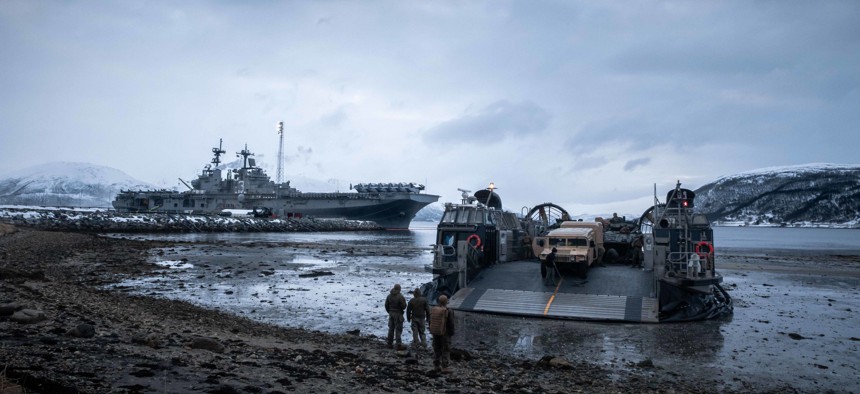
An LCAC hovercraft disembarks the Wasp-class amphibious assault ship USS Kearsarge (LHD 3) during a Marine Expeditionary Unit bilateral training event in Tromsø, Norway, April 12, 2022. U.S. Navy / Chief Mass Communication Specialist Oliver Cole
‘We Should Have Been There’: Marine General Laments the State of the Amphib Navy
A failure to deploy in February illustrates the low readiness of the nation’s amphibious warships, a Marine three-star tells Defense One.
Maintenance problems with three amphibious warships kept a Marine Expeditionary Unit from answering urgent orders to Europe earlier this year, and a deputy commandant fears it could happen again.
On Feb. 15, the Joint Staff sent prepare-to-deploy orders to the 22nd Marine Expeditionary Unit at Camp Lejeune, North Carolina, and to its associated Naval amphibious ready group. Their purpose: “provide bridging solutions” to Gen. Tod Wolters, the commander of U.S. European Command and NATO's Supreme Allied Commander Europe, according to Lt. Gen. Karsten Heckl, the commanding general of Marine Corps Combat Development Command and deputy commandant for Combat Development and Integration.
The 22nd MEU was already prepared to go. However, the maintenance status of the three warships of the Kearsarge Amphibious Ready Group was “so bad” they were not prepared to leave then or after the invasion, Heckl told Defense One on Thursday. They were even late to meet their original deployment date.
“When you get within X number of days of your deployment date, you’re placed basically on a [prepare-to-deploy order] and the Kearsarge ARG failed that as well. Which is basically a violation of orders from my perspective as a Marine, right? If the joint order tells you to be ready on X day, then you’re to be ready on X day, and they were not.”
Marine Corps officials did offer to deploy the MEU by other means, Heckl said, something that should not have to happen to a naval expeditionary force.
On March 16—a month and a day after the orders came down—most of the MEU departed Naval Station Norfolk, Virginia, aboard the amphibious assault ship Kearsarge (LHD 3) and the amphibious transport dock Arlington. The rest left aboard the dock landing ship Gunston Hall about a week or so later, Heckl said.
The incident came to light on Tuesday, when Heckl testified before the Senate Armed Services seapower subcommittee about the advanced procurement of the large amphibious ship LPD-33, the top request on the Marine Corps’ unfunded priorities list. Without the traditional amphibious L-class ships, the Marines cannot go where they are needed, the general said Tuesday, and the service is already struggling.
The 22nd MEU was intended to join the U.S. Navy’s already bulked-up presence in the European theater as concerns grew regarding Russia’s military buildup along Ukraine’s border. The USS Harry S. Truman aircraft carrier and its accompanying ships have been in the 6th Fleet area for months due to the Ukrainian crisis. Defense Secretary Lloyd Austin is keeping the carrier strike group in the region until he “decides that it’s time for the ship to rotate out,” Pentagon spokesman John Kirby said March 31.
Heckl did not know what specific missions Wolters would have assigned the 22nd MEU, which trains for everything from humanitarian resupply to storming a beach.
“The bottom line is we should have been there and had that available to the combatant commander and we weren't,” he said.
Heckl, who has served for 35 years as a Marine, said he was unaware of any previous time a MEU was told to deploy early and they could not respond.
He told lawmakers on Tuesday that the Marine Corps needs at least 31 traditional amphibious ships: 10 LHA/LHD “big-decks” and 21 LPDs. The number is based on the Navy’s Optimized Fleet Response Plan, which assumes the ships have an 80 percent readiness rate, Heckl said Thursday.
“The 10-year running average for the amphib Navy is 63 [percent]. Last month, it was 46 [percent],” he said. “So the number is only valid if the readiness rates are achieved and maintained, which today is simply not the case.”
The Navy currently has 32 ships. Last week, Heckl said, only 15, or 47 percent, were available.
Defense One asked Navy and 2nd Fleet officials about Heckl’s comments, the deployment of the 22nd MEU and the Kearsarge ARG, and the general readiness of the amphibious fleet. No response was received before publication.
Planned decommissioning will soon reduce the total number of active amphibs, he said.
“If we don't have intervention from Congress, we will absolutely go down to 24 or 25 amphibs in the next three to four years. Period. So, you can do the math there. We simply will not have Marine Expeditionary Units and ARGs out, or even available,” he said.
Historically, the Marine Corps would have “heel-to-toe deployments,” meaning that one MEU and ARG would be deploying as another returned home, he told lawmakers.
This incident with the Kearsarge ARG illustrates the state of readiness of the entire amphibious Navy, Heckl said, and “it is a very real possibility” that another MEU could be slow to respond to a crisis.
“And in the Navy's defense, I understand, you know, they have Columbia [submarine], the nuclear triad, and amphibs just unfortunately fall out on the bottom,” he said. “But the reality is that the mission sets that a MEU/ARG is most likely to do are very real, they're fairly regular, and pretty frequent. And unfortunately, we don't have the assets right now to respond like we should.”
The incident should not be overlooked, Heckl said.
“When the next thing happens, it's not a good place for a military to be, to be saying, ‘I hope the MEU is there.’ Hope is a very bad military strategy. But unfortunately…that's where we are, quite frankly.”





